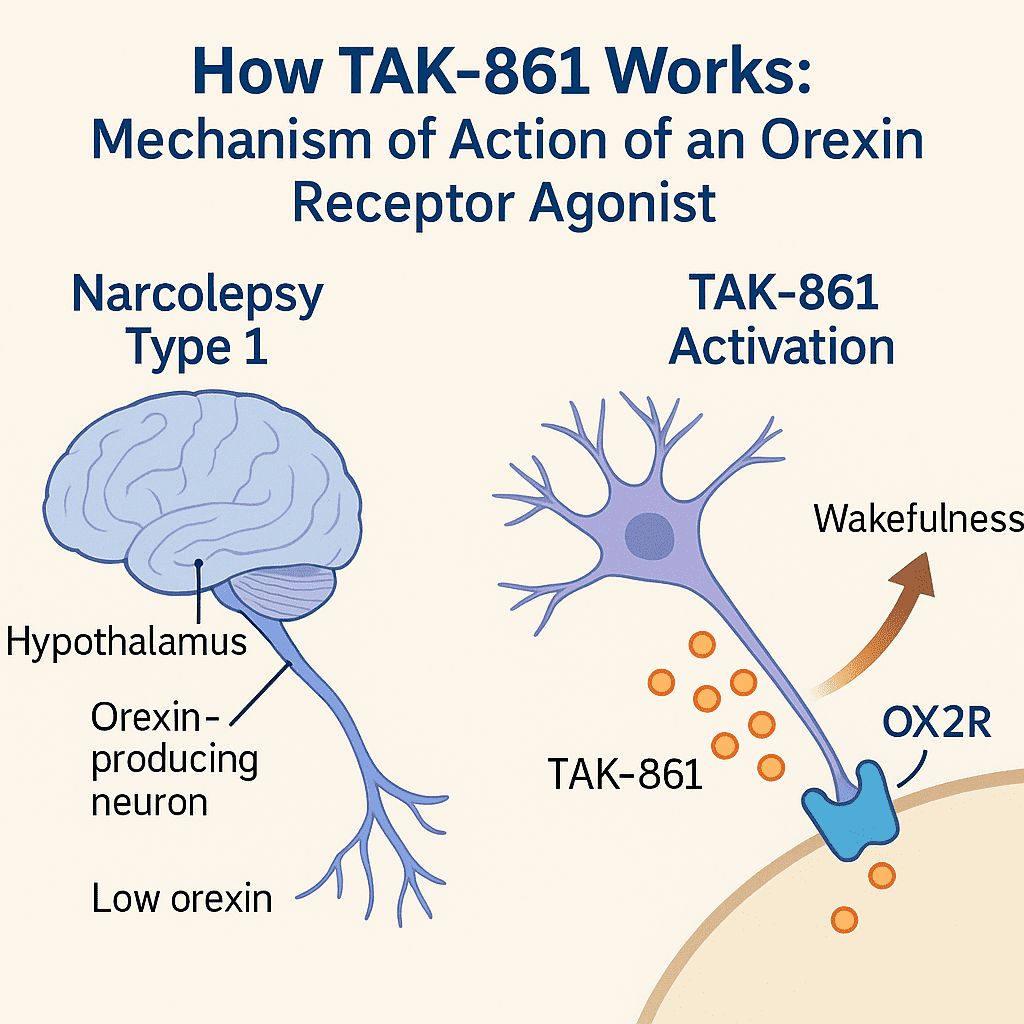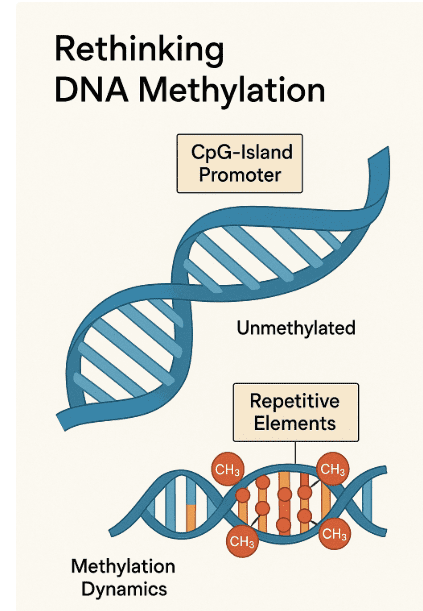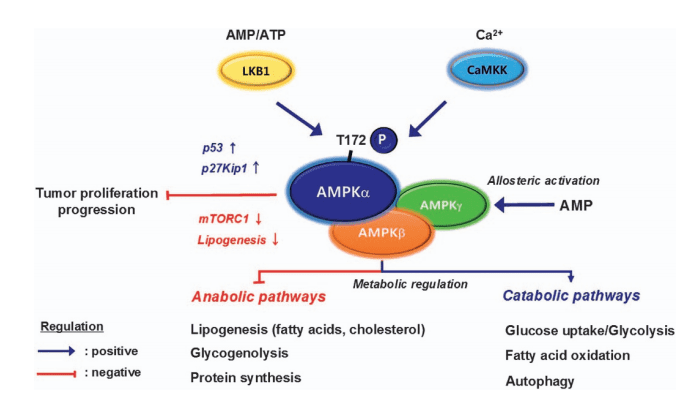NHDC Sweetener Guide: How Neosperidin Dihydrochalcone Is Changing Low-Calorie Foods
Abstract
Neosperidin dihydrochalcone (NHDC) is a high-intensity sweetener derived from citrus flavonoids, widely used in food, beverage, and pharmaceutical products. Recognized for its powerful sweetness—up to 1,500 times that of sucrose—NHDC is non-caloric, heat-stable, and effective at masking bitterness. It is produced through hydrogenation of neohesperidin, a compound found in bitter oranges. Approved in the EU and other markets, NHDC supports sugar reduction strategies and is suitable for diabetic-friendly and low-calorie formulations. Despite some regulatory and sensory limitations, NHDC remains a valuable tool for formulators seeking to balance taste, functionality, and health-conscious product development in modern food systems.
What is Neosperidin Dihydrochalcone (NHDC)?
Neosperidin dihydrochalcone (NHDC) is a high-intensity, low-calorie sweetener derived from a natural citrus flavonoid known as neohesperidin, which is primarily found in bitter oranges (Citrus aurantium). Through a chemical process involving hydrogenation, neohesperidin is transformed into NHDC—a compound that can be up to 1,500 times sweeter than sucrose, especially in low concentrations.
NHDC is not only valued for its extreme sweetness but also for its flavor-enhancing properties. It has a delayed onset of sweetness and a lingering aftertaste, making it a preferred additive in various food and pharmaceutical applications. In particular, NHDC is often used in sugar-free, low-calorie, and diabetic-friendly products due to its negligible caloric content and lack of glycemic impact.
First discovered in the 1960s during a U.S. Department of Agriculture research project, NHDC has since gained regulatory approval in multiple regions, including the European Union, where it is listed as food additive E-959. It is recognized as safe by international food safety authorities and has been widely adopted in products such as beverages, dairy products, confectionery, chewing gum, and oral care products.
Beyond its sweetness, NHDC also serves as a bitterness masker, helping improve the palatability of various food ingredients, especially in products containing vitamins, minerals, or herbal extracts with naturally bitter profiles.
As demand continues to grow for clean-label and sugar-reduction strategies, NHDC offers a promising solution for formulators seeking effective sweetening alternatives that deliver both taste and functionality.
How is Neosperidin Dihydrochalcone (NHDC) Made?
The production of Neosperidin Dihydrochalcone (NHDC) is a chemically guided transformation of natural citrus flavonoids into a potent sweetener. The starting material is neohesperidin, a compound naturally found in bitter oranges (Citrus aurantium). This compound belongs to the flavanone glycosides group, which are known for their bitter flavor and antioxidant properties.
The process begins by isolating neohesperidin from citrus peels, often as a byproduct of juice production. The isolated compound then undergoes a hydrogenation reaction in an alkaline medium. During this step, the flavanone structure is converted into a dihydrochalcone structure—this is the critical modification that turns the original bitter-tasting molecule into one with sweetening properties.
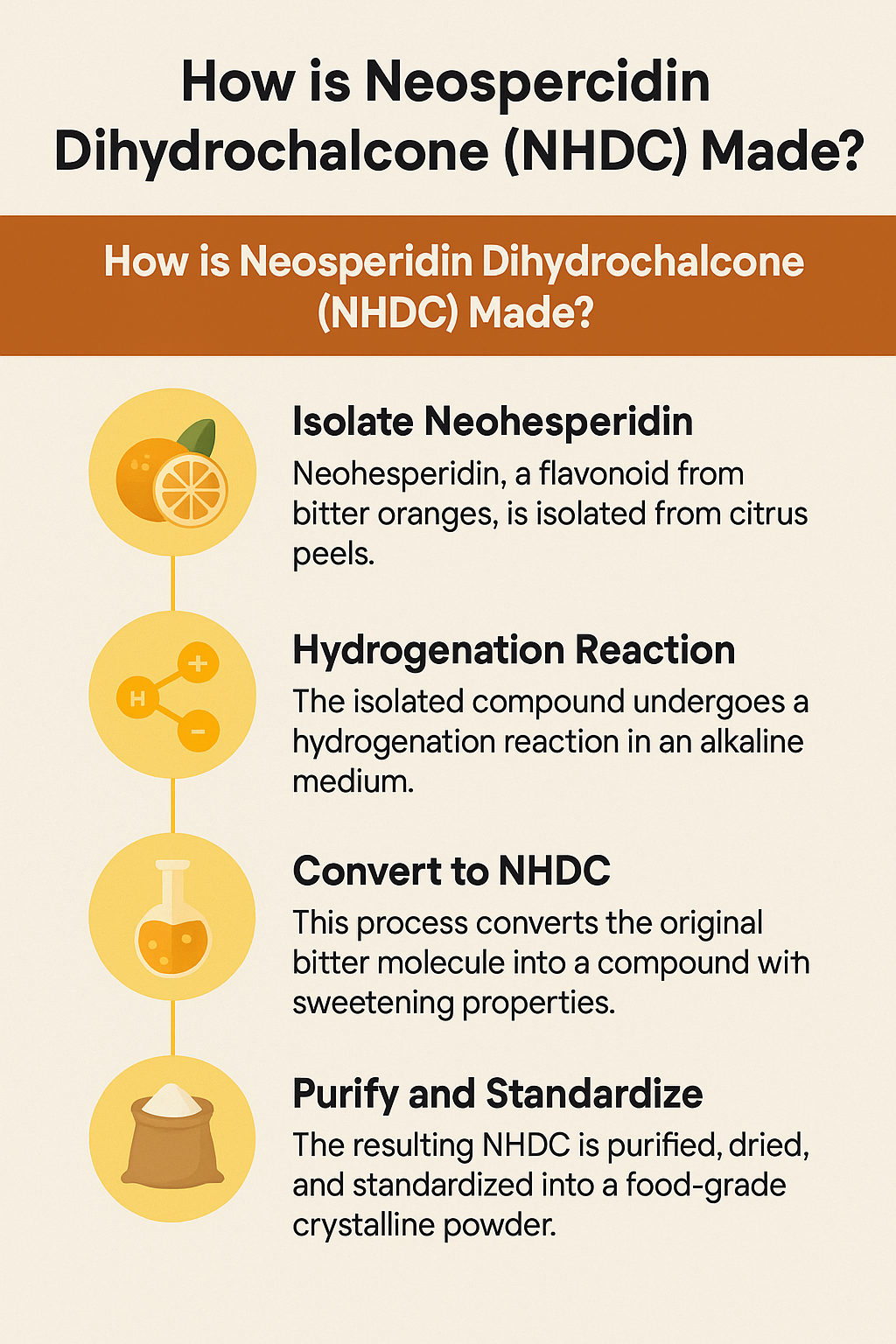
Hydrogenation alters the double bonds in the molecule and results in a compound that is significantly sweeter than sugar. The resulting NHDC is then purified, dried, and standardized into a crystalline powder suitable for food-grade use. This process is scalable and cost-effective, making NHDC a commercially viable sweetener for a variety of applications.
Notably, NHDC is heat-stable, pH-resistant, and can maintain its sweetness profile over long shelf lives. These qualities make it ideal not only as a standalone sweetener but also as a sweetness enhancer when blended with other artificial or natural sweeteners like aspartame, acesulfame K, or stevia.
The ability to synthesize a natural-origin molecule into a high-intensity sweetener demonstrates a key intersection of food science and industrial chemistry, with implications for healthier product formulation in the food, beverage, and pharmaceutical industries.
Why is NHDC Used as a Sweetener?
Neosperidin dihydrochalcone (NHDC) is used as a sweetener primarily because of its exceptional sweetness intensity and unique functional properties. It is between 400 and 1,500 times sweeter than sucrose, especially effective at low concentrations. This potency makes it ideal for applications requiring sweetness without the bulk or calories of traditional sugars.
NHDC offers a delayed sweetness onset followed by a lingering sweet aftertaste, which is especially valuable in combination with other sweeteners. It is commonly used in synergy with compounds like aspartame, saccharin, stevia, and acesulfame K to enhance their sweetness profiles while masking bitter or metallic aftertastes. This blending effect improves overall flavor balance, making NHDC highly sought after in the formulation of complex products.
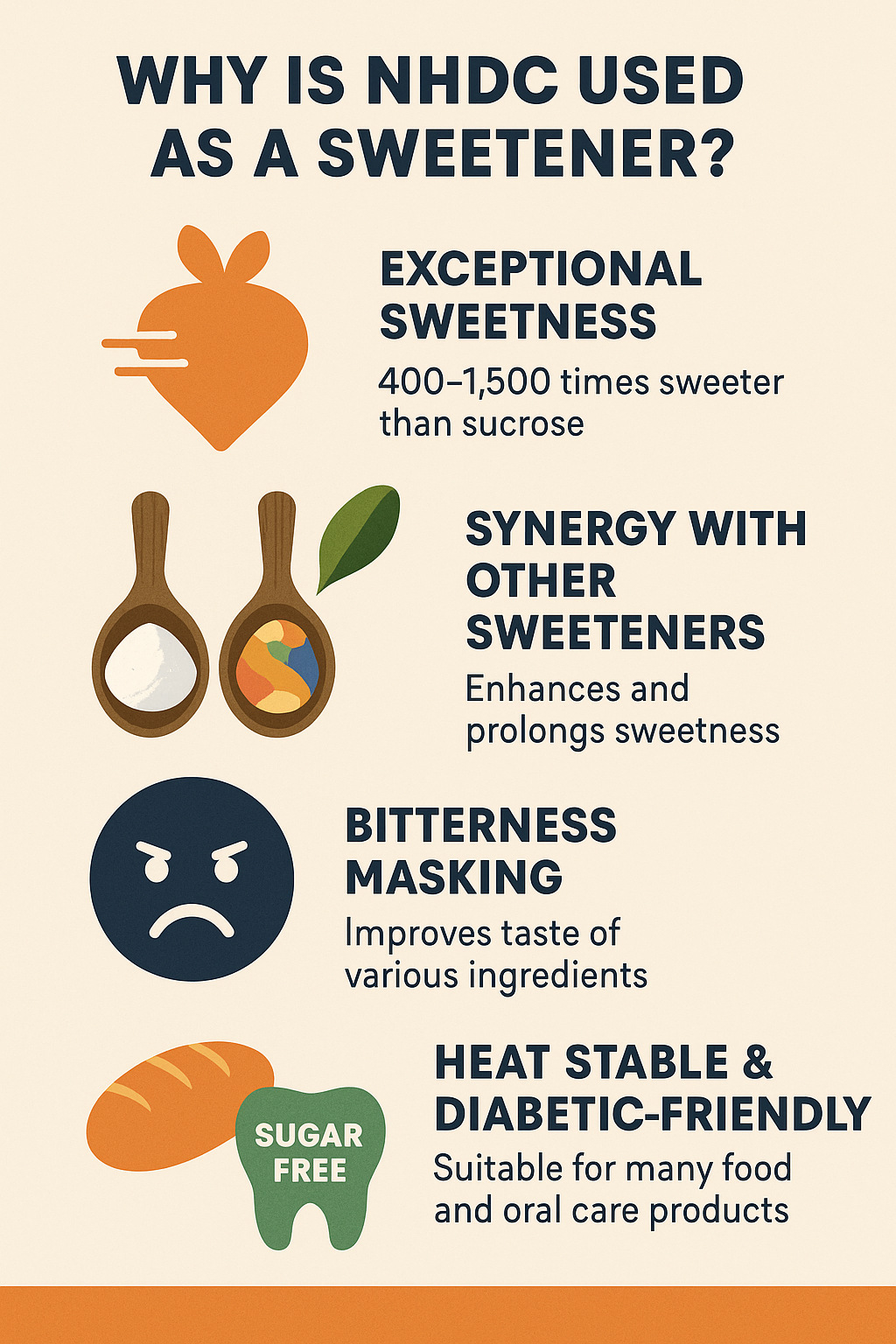
Another major advantage of NHDC is its bitterness-masking property. This is particularly useful in pharmaceuticals, dietary supplements, and functional foods, where active ingredients like vitamins, minerals, and plant extracts can impart unpleasant tastes. NHDC can reduce bitterness without compromising efficacy, helping to improve consumer compliance and satisfaction.
NHDC is also stable at high temperatures and across a wide pH range, which makes it suitable for baked goods, canned beverages, and other heat-processed foods. Additionally, because NHDC is non-cariogenic and has a negligible effect on blood glucose levels, it is ideal for diabetic-friendly and oral health products like sugar-free chewing gum and toothpaste.
With increasing demand for low-calorie, clean-label, and functional food alternatives, NHDC provides formulators with a powerful tool to enhance sweetness while improving product appeal and reducing sugar content.
Health and Safety Profile of NHDC
Neosperidin dihydrochalcone (NHDC) has been extensively studied and evaluated by food safety authorities worldwide and is considered safe for human consumption when used within established guidelines. Its approval by major regulatory bodies, such as the European Food Safety Authority (EFSA) and the U.S. Food and Drug Administration (FDA), supports its widespread use in foods, beverages, and oral care products.
In the European Union, NHDC is listed as food additive E-959, and its Acceptable Daily Intake (ADI) has been evaluated without notable safety concerns. The EFSA’s comprehensive review confirmed that NHDC is not genotoxic, carcinogenic, or mutagenic, and does not pose risks related to reproductive or developmental toxicity. Similarly, the Joint FAO/WHO Expert Committee on Food Additives (JECFA) concluded that NHDC could be safely consumed within the evaluated limits.
One of NHDC’s major health benefits is its non-caloric nature. Since the compound is not metabolized like sugars, it provides zero calories and does not raise blood glucose levels. This makes it an attractive option for individuals managing diabetes, obesity, or following low-glycemic diets. Furthermore, NHDC does not promote dental cavities (i.e., it is non-cariogenic), making it suitable for oral health products like mouthwash and toothpaste.
Toxicological studies have also found NHDC to be well-tolerated even at high doses in animal models, with no adverse effects on organs, reproduction, or behavior. However, as with all additives, long-term exposure at very high levels is still monitored under ongoing safety evaluations.
Overall, NHDC is a well-regulated, thoroughly vetted ingredient that aligns with global efforts to reduce sugar intake and promote healthier dietary patterns.
Benefits and Drawbacks of Neosperidin Dihydrochalcone (NHDC)
Like many food additives, Neosperidin dihydrochalcone (NHDC) offers distinct advantages but also comes with some limitations. Understanding both sides is key for food developers, health professionals, and informed consumers.
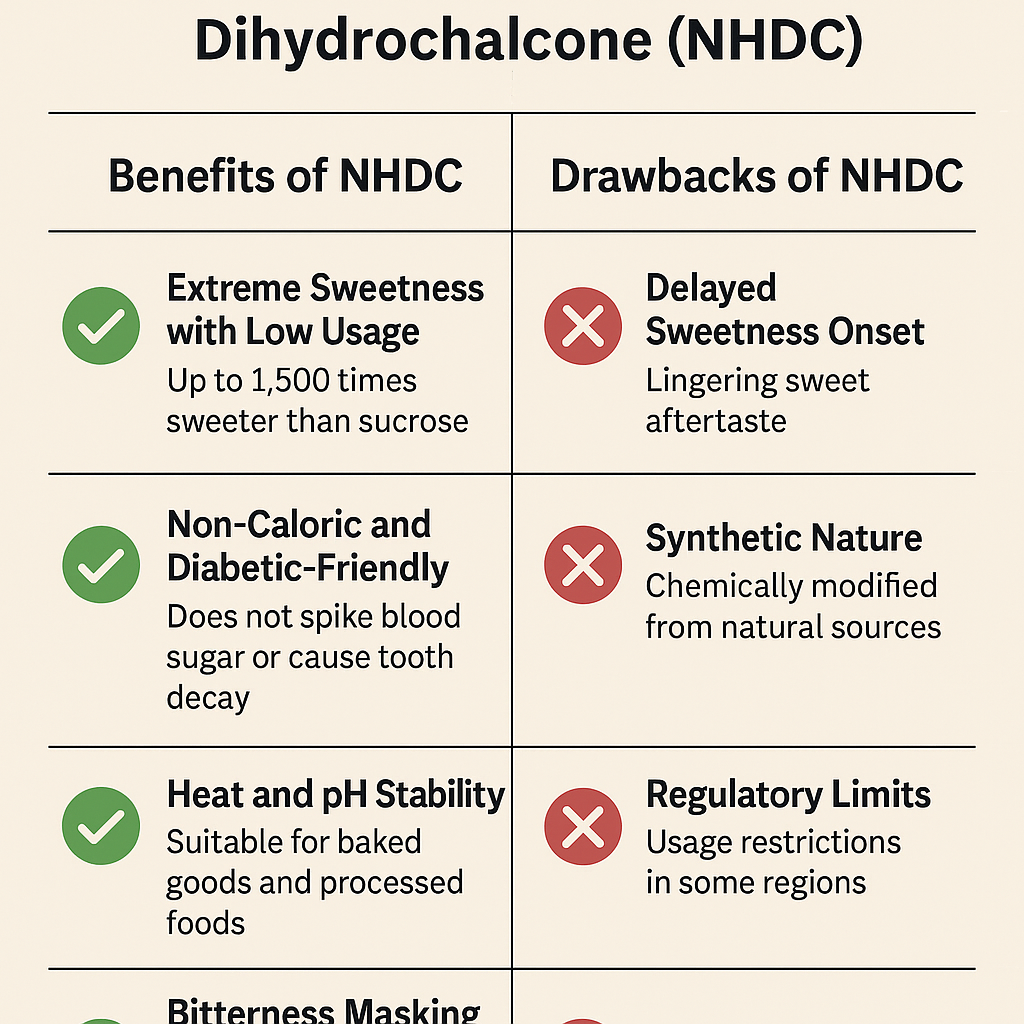
Benefits of NHDC
Extreme Sweetness with Low Usage
NHDC’s sweetness is up to 1,500 times that of sucrose. This means only very small amounts are needed to achieve desired sweetness, reducing calorie content significantly.
Non-Caloric and Diabetic-Friendly
NHDC is non-glycemic and non-cariogenic, making it suitable for diabetics and oral health applications. It does not contribute to blood sugar spikes or tooth decay.
Heat and pH Stability
Unlike some artificial sweeteners that degrade under heat or acidic conditions, NHDC remains stable in a wide pH range and at high temperatures. This makes it suitable for baked goods, canned beverages, and processed foods.
Bitterness Masking and Flavor Enhancement
NHDC can mask bitterness and enhance flavors. It is widely used in pharmaceuticals, dietary supplements, and products with challenging taste profiles (e.g., plant-based proteins, vitamins).
Drawbacks of NHDC
Delayed Sweetness Onset
NHDC has a slow onset and a lingering sweet aftertaste, which can be undesirable in some food products unless blended with other sweeteners.
Synthetic Nature
Although derived from natural sources, NHDC is chemically modified, which may deter clean-label consumers seeking purely natural ingredients.
Regulatory Limits
NHDC is not approved everywhere (e.g., the U.S. FDA has not yet granted GRAS status), and its use is subject to strict dosage limits.
Despite these minor limitations, NHDC remains a valuable tool for sugar reduction strategies, especially when used in synergy with other sweeteners.
Conclusion: Should You Use NHDC in Your Products?
As global consumers increasingly demand low-sugar, calorie-conscious, and functional foods, Neosperidin dihydrochalcone (NHDC) has emerged as a valuable tool for formulators and product developers. Its exceptional sweetening power, stability, and taste-enhancing properties make it especially attractive for complex product formulations across the food, beverage, and pharmaceutical industries.
NHDC’s role extends beyond sweetness. Its bitterness-masking effects are especially useful in improving the palatability of nutraceuticals, oral care products, and herbal supplements. It is also ideal for use in diabetic-friendly and weight-management products due to its non-caloric nature and glycemic neutrality.
However, while NHDC is widely approved in regions like the European Union (E-959) and parts of Asia, it has not yet been universally adopted, particularly in the United States, where GRAS (Generally Recognized as Safe) status remains pending. Additionally, its synthetic label may deter brands targeting a clean-label or “all-natural” image.
For product developers aiming to reduce sugar while maintaining palatability, NHDC works best when blended with other sweeteners such as stevia, monk fruit extract, or aspartame. This allows brands to balance cost, flavor, and regulatory compliance more effectively.
In summary, NHDC is an innovative sweetener with a strong track record of safety, versatility, and effectiveness. Whether used alone or in combination, it offers a compelling solution for modern food challenges—especially in an era of sugar reduction mandates and evolving health-conscious consumers.
References
DuBois, G. E., & Prakash, I. (2012). Non-caloric sweeteners, sweetness modulators, and sweetener enhancers. Annual Review of Food Science and Technology, 3, 353–380.
https://www.annualreviews.org/content/journals/10.1146/annurev-food-022811-101236
DuBois, G. E. (2016). Molecular mechanism of sweetness sensation. Physiology & Behavior, 164(Pt B), 453–463. https://doi.org/10.1016/j.physbeh.2016.03.015
https://www.sciencedirect.com/science/article/abs/pii/S0031938416301019
Kinghorn, A. D., & Soejarto, D. D. (2002). Discovery of terpenoid and phenolic sweeteners from plants. Pure and Applied Chemistry, 74(7), 1169–1179.
https://www.degruyterbrill.com/document/doi/10.1351/pac200274071169/html
Bellisle, F. (2015). Intense sweeteners, appetite for the sweet taste, and relationship to weight management. Current Obesity Reports, 4(1), 106–110.


